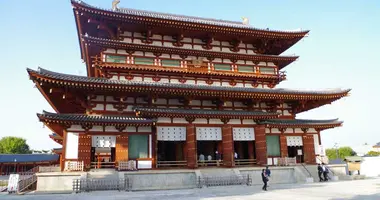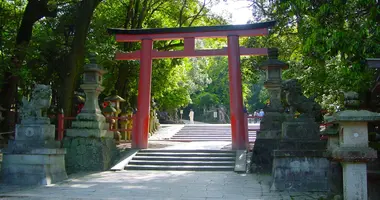Saidaiji Temple
Saidaiji Temple (西大寺) in Nara was one of the original Seven Great Temples of Nara and is the headquarters of the Shingon Risshu sect of Japanese Buddhism.
- History of Saidaiji Temple
- Saidaiji Temple Buildings
- Access - Getting To Saidaiji
- Japan Temples & Shrines
Saidaiji Temple, Nara 西大寺
Saidaiji Temple, a large temple complex in Nara, is located a minute or two from Kintetsu Yamato-Saidaiji Station.
Saidaiji (Great Western Temple) was established in 765 as a counterpart to Todaiji (Great Eastern Temple), which it once rivaled in size and importance.
Once one of the "Seven Great Temples" of Nara which included Daianji, Gangoji, Kofukuji, Horyuji, Todaiji and Yakushiji, Saidaiji suffered from repeated fires during its history and is now not as visited as other more famous temples in Nara.
Saidaiji is the head temple of the Shingon Risshu (真言律宗) sect of Japanese Buddhism.
 Shio-do Hall, Saidaiji Temple, Nara
Shio-do Hall, Saidaiji Temple, Nara Hondo (Main Hall), Saidaiji Temple, Nara
Hondo (Main Hall), Saidaiji Temple, Nara
History of Saidaiji Temple
Saidaiji was founded during the Nara Period by the Empress Koken, known for her turbulent reign and her supposed affair with the priest Dokyo. The temple complex is said to have had around a hundred buildings at its peak.
Saidaiji declined in importance after the capital moved to Kyoto from the Heian Period, though its fortunes were revived by the priest Eison (1201-1290), the founder of Shingon-risshu Buddhism, who took over the administration of the temple in 1238 during the Kamakura Period.
Fire again ravaged the temple in 1502 and most of the buildings we can see today were built in the Edo Period. A five story pagoda was lost in this fire but the stone foundations of the tower can still be seen.

Shio-do Hall, Saidaiji Temple, Nara Pond, Saidaiji Temple, Nara
Pond, Saidaiji Temple, Nara
Saidaiji Temple Buildings
The four main buildings of Saidaiji Temple can be entered using a combined ticket.
The Main Hall contains a wooden, standing statue of Sakyamuni. Measuring 1.7m in height, the statue was erected during the time of Eison in 1249 and is classified as an Important Cultural Property. The Main Hall (Shakado) was constructed in 1752 and restored in 1808.
The Shio-do dates from 1674 and contains statues of an Eleven-Headed Bodhisattva (Avalokiteshvara) and the Four Heavenly Kings (shitenno).
The Aizen-do was constructed in 1762 and houses a fearsome red-faced statue of Aizen Myo-o, an esoteric deity believed to channel worldly lust and sexual desire in to spiritual enlightenment.
The modern, concrete Shuhokan (Treasure House) is the other building entered on the combined ticket and contains the many treasures of the temple including statues from the Heian, Kamakura and Edo periods, a fine reliquary and Buddhist ritual implements such as vajra and hand bells.
 Entrance Gate, Saidaiji Temple, Nara
Entrance Gate, Saidaiji Temple, Nara
Around twenty other buildings and a small shrine make up the rest of the temple buildings.
Saidaiji is completely walled though the temple grounds are not the prettiest. A few small ponds add some color to the otherwise rather dusty precincts of the temple, which includes a lively kindergarten.
Saidaiji is also known for its ochamori, when on the second Saturday and Sunday of April participants can take part in an unusual tea ceremony, drinking from a bowl about the size of a man's head. Help is usually needed to get the bowl to your lips.
A visit to Saidaiji can be combined with a trip to Akishino Temple about 1.5km to the north which also dates from the Nara Period, known for a statue of Gigeiten, the Goddess of the Arts. The dry lacquer head is original Nara Period, while the body is attributed to the famed Kamakura era sculptor Unkei.
Saidaiji (saidaiji.or.jp)
1-1-5 Saidaijishiba-machi
Nara, Nara Prefecture 631-0825
Tel: 0742 45 4700
Hours: 9 am-4.30 pm
Admission: 1000 yen for a combined ticket. Individual tickets are Hondo (400 yen), Aizen-do (300 yen), Shio-do (300 yen) and Treasure House (300 yen).
Access - how to get to Saidaiji Temple
Saidaiji is a short walk from the South Exit of Yamato-Saidaiji Station two stops west from Kintetsu Nara Station.
By bus from JR Nara Station take the #12 or #14 bus to Yamato-Saidaiji Station.
 Huge tea bowl used in the ochamori tea ceremony, Saidaiji Temple, Nara
Huge tea bowl used in the ochamori tea ceremony, Saidaiji Temple, Nara
















